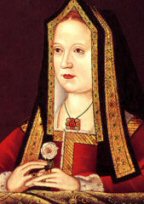 |
| Elizabeth of York - see, that Tudor rose branding worked! |
When her father, Edward IV, became ill and died a few weeks later it set in motion a chain of events that had Elizabeth of York, her mother, and all of her siblings, suddenly on the run for their lives.
Her younger brother, Prince Edward, now Edward V, was intercepted by their father's brother, Richard.
Under the guise of 'bringing the young king to the Tower for pre-coronation safety and lessons,' Uncle Richard tipped his hand a little when he immediately had the companions of the new twelve-year-old king arrested and executed.
Elizabeth Woodville (a.k.a. "Mom") to the whole royal brood smelled a rat immediately and bolted with her children to the sanctuary of Westminster Abbey.
There they were shielded somewhat from suddenly-psycho, power-grabbing Uncle Richard - but when that same Uncle Richard showed up, banging on the door of Westminster Abbey and asking if Edward V's little brother, also Richard, could come out to play at the Tower with the new king, Elizabeth Woodville decided to cut her losses with the two boys who were basically no longer hers to save.
She sent Prince Richard (aged 9) out, hoping that would satisfy Psycho Uncle Richard, and that he'd leave the rest of the family alone.
Once Prince Richard and Edward V entered the Tower of London, they simply . . . vanished.
| poof - just like that - two little princes, never again seen alive |
So, that's how the late-teen years went down for Elizabeth of York: peace, calm, tragedy when her dad died, sudden heart-stopping fear and grief for her tender little brothers and herself that went on for months.
That kind of mental shock will leave a mark.
But women in Tudor times were tough.
When Psycho Uncle Richard declared himself Richard III - Self-Appointed King of Everything, Elizabeth Woodville and Margaret Beaufort, mother of Henry Tudor, the future Henry VII, hunkered down and clandestinely lined up the church and catering hall for the marriage of Elizabeth of York and Henry Tudor/Henry VII.
The two women saw it as a means to an end - if it came to pass, the marriage alliance of their children would unite the country's two warring factions who'd been pissy with one another for years.
Perhaps it started out as a pie-in-the-sky idea, but as time went on and the two women cunningly used a shared physician to pass information back and forth, the dream started to take shape.
There were fits and starts - Henry Tudor failed in his first attempt to re-enter the country to stake his claim (he'd been in exile for his own safety - something else he and Elizabeth of York had in common) and
Then the fairy-tale of Henry Tudor taking the throne of England and marriage to Elizabeth of York *actually* became reality.
Henry Tudor and his army met Richard III on the battlefield, and Richard III died in an ugly way that involved a large chunk of his skull caved in.
Game over, man.
His nekkid body was abused horrifically, although Henry VII told the happy abusers to leave Richard's face untouched, strapped to a horse and paraded around so the people could see he wasn't merely dead, but really, most sincerely, dead.
Henry Tudor's step-father (according to legend) picked up the crown Richard III would no longer be using, and placed it on Henry's head.
Enter battlefield as Henry Tudor, exit battlefield as Henry VII, King of England, Lord of Ireland, and ruler of Wales.
Off went Henry VII to his own coronation, no doubt blinking a lot at how quickly the best possible outcome had come down, and he almost simultaneously married Elizabeth of York.
Here's where the team work/dream work bit comes in - one of the first things Henry VII did was to unite the two colors of rose used by both sides formerly in contention for the throne - and slap that hybrid rose brand on everything.
 |
| "Yeah, I want this era branded so put this logo on everything. Tudor red rose should be bigger than the other guy's white rose logo. " |
We're all good, here, people, and everyone needs to settle down.
In true fairy-tale tradition, Elizabeth of York birthed a baby boy, Prince Arthur, eight months after her wedding to Henry VII. (Hmm.)
| First-born and a son! |
When their son, Prince Arthur, married Catherine of Aragon, Henry VII and Elizabeth of York watched from a 'closet made properly with lattice windows' - secretly, so as to not steal the thunder from their son's wedding.
When Prince Arthur unexpectedly died a scant five months later, leaving only their 'spare,' Prince Henry (Henry VIII) Elizabeth of York, although crushed by sadness and too old by Tudor standards to have more children, told Henry VII that if he was willing to try for another boy, she was willing.
They did try.
The baby, a stillborn girl, was the second disappointment in the fairy-tale.
The final disappointment was when Elizabeth of York died shortly afterwards, on her thirty-seventh birthday, 11 February 1503.
 |
| Henry VII - competent and careful, made sure his wife had a grave appropriate to her, and her husband's, status as king and queen. His son, Henry VIII - capricious and impulsive, didn't plan his grave, and so was tossed in with some other relative in St. George's Chapel, Windsor Castle. |
The shadow she cast was a long one; her notoriously fickle and capricious son, Henry VIII, could always find fault whenever his current wife didn't stand up to the memory of his mother.
Tellingly, the quality he loved and treasured most about his mother was that she had 'never defied her husband, the King.'
Pay attention, Anne Boleyn.
No comments:
Post a Comment